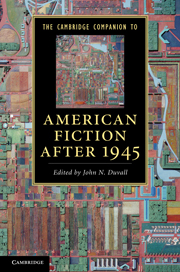Book contents
- Frontmatter
- Introduction: A story of the stories of American fiction after 1945
- PART I POETICS AND GENRES
- 1 Postmodern metafiction
- 2 Contemporary realism
- 3 New journalism and the nonfiction novel
- 4 Science fiction
- 5 The short story
- PART II HISTORICAL AND CULTURAL CONTEXTS
- PART III MAJOR AUTHORS
- Conclusion: Whither American fiction?
- Index
- Cambridge Companions to …
2 - Contemporary realism
from PART I - POETICS AND GENRES
Published online by Cambridge University Press: 28 March 2012
- Frontmatter
- Introduction: A story of the stories of American fiction after 1945
- PART I POETICS AND GENRES
- 1 Postmodern metafiction
- 2 Contemporary realism
- 3 New journalism and the nonfiction novel
- 4 Science fiction
- 5 The short story
- PART II HISTORICAL AND CULTURAL CONTEXTS
- PART III MAJOR AUTHORS
- Conclusion: Whither American fiction?
- Index
- Cambridge Companions to …
Summary
Despite the formal innovations of the high postmodernists, the vast majority of American fiction published since 1945 has made no pretense of being avant-garde or experimental, but rather has remained unabashedly realist in its rendering of character, setting, and time. This is not surprising. As Raymond Carver once remarked, true formal innovation in fiction, while “cause for rejoicing,” is exceedingly rare. Too often what has been proclaimed innovative has proven on closer examination to be little more than the repetition of certain postmodernist devices (self-reflexivity in narration, for example) that long ago lost their ability to surprise. Indeed, during the period in question, realism has proven to be far more resilient and adaptable to change than “metafiction,” “surfiction,” “fabulism,” or any of the other -isms subsumed under the umbrella of literary postmodernism. The fact is, realism continued to be practiced by major writers throughout the period of high postmodernism, and the years since 1980 have witnessed the emergence of a renewed or revitalized realism marked by its variety and wide range of effects. Because of this it makes sense to speak not of a monolithic realism, but rather of a number of different, at times overlapping, realisms, all of them making use of a common core of techniques and exhibiting the same belief in the power of language to accurately represent life “as it really is.”
- Type
- Chapter
- Information
- The Cambridge Companion to American Fiction after 1945 , pp. 30 - 43Publisher: Cambridge University PressPrint publication year: 2011
- 1
- Cited by

